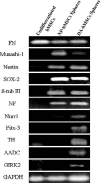Adult human bone marrow stromal spheres express neuronal traits in vitro and in a rat model of Parkinson's disease
- PMID: 16828720
- PMCID: PMC1949017
- DOI: 10.1016/j.brainres.2006.05.109
Adult human bone marrow stromal spheres express neuronal traits in vitro and in a rat model of Parkinson's disease
Abstract
Adult human bone marrow stromal cells (hMSCs) grown in suspension culture gave rise to spheres of neural progenitor (NP) cells, capable of expressing both dopaminergic (DA) and GABAergic (GABA) traits. After transplantation into the Parkinsonian rat, human NPs and neurons were present at 2 weeks. Although no DA neurons appeared to survive transplantation, there were abundant GABA neurons present in the graft. By 4 weeks, however, all cells had died. Finding ways to prolong survival and promote the appropriate neurotransmitter phenotype is essential if hMSCs are to be clinically useful.
Figures




Similar articles
-
A protocol for the differentiation of human embryonic stem cells into dopaminergic neurons using only chemically defined human additives: Studies in vitro and in vivo.Brain Res. 2007 Jan 5;1127(1):19-25. doi: 10.1016/j.brainres.2006.10.022. Epub 2006 Nov 21. Brain Res. 2007. PMID: 17123482 Free PMC article.
-
Combination of bone marrow stromal cell transplantation with mobilization by granulocyte-colony stimulating factor promotes functional recovery after spinal cord transection.Acta Neurochir (Wien). 2009 Nov;151(11):1483-92. doi: 10.1007/s00701-009-0402-6. Epub 2009 Jun 5. Acta Neurochir (Wien). 2009. PMID: 19499175
-
Intracerebral transplantation of bone marrow stromal cells in a 1-methyl-4-phenyl-1,2,3,6-tetrahydropyridine mouse model of Parkinson's disease.Neurosci Lett. 2001 Dec;316(2):67-70. doi: 10.1016/s0304-3940(01)02384-9. Neurosci Lett. 2001. PMID: 11742717
-
Generation of dopaminergic neurons from embryonic stem cells.J Neurol. 2002 Sep;249 Suppl 2:II41-4. doi: 10.1007/s00415-002-1208-0. J Neurol. 2002. PMID: 12375063 Review.
-
Embryonic and adult stem cells as a source for cell therapy in Parkinson's disease.J Mol Neurosci. 2004;24(3):353-86. doi: 10.1385/JMN:24:3:353. J Mol Neurosci. 2004. PMID: 15655260 Review.
Cited by
-
Unrestricted somatic stem cells from human umbilical cord blood grow in serum-free medium as spheres.BMC Biotechnol. 2009 Dec 15;9:101. doi: 10.1186/1472-6750-9-101. BMC Biotechnol. 2009. PMID: 20003538 Free PMC article.
-
Human neural stem cell grafts in the spinal cord of SOD1 transgenic rats: differentiation and structural integration into the segmental motor circuitry.J Comp Neurol. 2009 Jun 1;514(4):297-309. doi: 10.1002/cne.22022. J Comp Neurol. 2009. PMID: 19326469 Free PMC article.
-
Human adipose-derived mesenchymal stem cells improve motor functions and are neuroprotective in the 6-hydroxydopamine-rat model for Parkinson's disease when cultured in monolayer cultures but suppress hippocampal neurogenesis and hippocampal memory function when cultured in spheroids.Stem Cell Rev Rep. 2015 Feb;11(1):133-49. doi: 10.1007/s12015-014-9551-y. Stem Cell Rev Rep. 2015. PMID: 25120226
-
Transplantation of neuronal-primed human bone marrow mesenchymal stem cells in hemiparkinsonian rodents.PLoS One. 2011;6(5):e19025. doi: 10.1371/journal.pone.0019025. Epub 2011 May 23. PLoS One. 2011. PMID: 21625433 Free PMC article.
-
MPP+ decreases store-operated calcium entry and TRPC1 expression in Mesenchymal Stem Cell derived dopaminergic neurons.Sci Rep. 2018 Aug 6;8(1):11715. doi: 10.1038/s41598-018-29528-x. Sci Rep. 2018. PMID: 30082759 Free PMC article.
References
-
- Brazelton TR, Rossi FM, Keshet GI, Blau HM. From marrow to brain: expression of neuronal phenotypes in adult mice. Science. 2000;290:1775–1779. - PubMed
-
- Caterson EJ, Nesti LJ, Danielson K, Tuan RS. Human marrow-derived mesenchymal progenitor cells: isolation, culture expansion, and analysis of differentiation. Mol. Biotechnol. 2002;20:245–256. - PubMed
-
- Dauer W, Przedborski S. Parkinson's disease: mechanisms and models. Neuron. 2003;39:889–909. - PubMed
-
- Deng W, Obrocka M, Fischer I, Prockop DJ. In vitro differentiation of human marrow stromal cells into early progenitors of neural cells by conditions that increase intracellular cyclic AMP. Biochem. Biophys. Res. Commun. 2001;282:148–152. - PubMed
Publication types
MeSH terms
Substances
Grants and funding
LinkOut - more resources
Full Text Sources
Other Literature Sources
Medical
Miscellaneous

